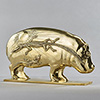ILLUSTRATED:
Trémois: Bestiaire Fabuleux Sculptures , Michèle Broutta Éditeur, Paris, 1977, color illustrated, pp. 56 - 57; black and white illustrated, p. 174
Jacques-Louis Binet, Trémois: Peintures, Gravures , Sculptures, Éditions du Rocher, Éditions Vision Nouvelle, Paris, 1991, color illustrated, p. 119
This sculpture is to be sold with a certificate of authenticity signed by the artist.
Catalogue Note:
RÊVES DE FÉCONDATIONS
ENGROSSÉE DE SONGES INDÉCIS…GÉNITRICE
LOURDEURS MAMMAIRES
GENÈSE SILENCIEUSES, BÂILLEMENT, DÉSIRS VÉGÉTARIENS, TORPEURS DIGESTIVES
LANGUEURS HYPOSTATIQUES DANS LE LIT RIVIÈRES AUX EAUX DORMANTES…
-"HIPPOPODAME" BY PIERRE-YVES TRÉMOIS
Trémoi s borrowed t he name of t he f amous 1973 song Hippopodame, by the legendary French singer Serge Gainsbourg as the name for his hippopotamus sculpture in the Darwin series. Known as a bad boy, Gainsbourg played with words and changed the French spelling for 'hippopotamus': The 't' in 'hippopotame' is changed to a 'd', making the end 'dame,' or 'madame' in French. The entire song displays his love for plump female beauty. Trémois' citation not only matches the sculpture's theme very wel l , but also adds some humor to it, further highlighting its timeliness and reverberating with the zeitgeist.
Hippopodame was created in 1977. The sun protrudes slightly out of the golden surface. Smooth and beaming, the engraved Horus symbolizes the Egyptian god of lights, Horus. The two lively crocodiles under the sunbeams seem to be having an adventure in mythology — the mysterious force of Ancient Egypt. The incuse on the sculptures of the Darwin series: a series of words carved on the other side of the sculpture. Combining French and Latin, it becomes a unique language. The idea of the creation is infused into the work. The sharp writing is full of wordplay. Knowledge and an open mind are essential elements for realizing the subtleties within.
Rational and strong, decisive and concise — such is Trémois' style. He has drawn inspiration from the Darwin's well-known Theory of Evolution. It explores and contemplates deeply the origin of all beings, the evolution of life, and the meaning of existence. The lines are delicately carved into such hard metals. Images borrowed from biology, including human beings, other animals, and cells, puts one in awe of the primordial forces. Holding onto the spirit of a humanist scholar, Trémois has a strong interest in Eastern cultures, biology, and astronomy. He has delved into these fields for many years, internalizing his vast knowledge into his work.
Born in 1921, Trémois studied at the École nationale supérieure des Beaux-arts de Paris, and won the Prix de Rome when he was only twenty-two. Later on, he became a member of the Accademia delle Arti del Disegno of Florence, the Royal Flemish Academy of Belgium, and, in 1978, of the Académie Française. Such honors show Trémois' extraordinary status in the world of art.


